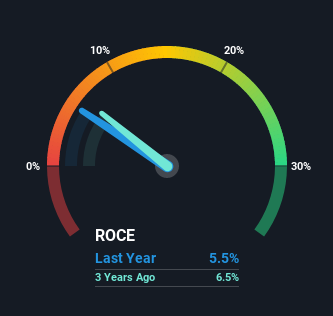- United States
- /
- Beverage
- /
- NasdaqCM:WVVI
Here's What's Concerning About Willamette Valley Vineyards' (NASDAQ:WVVI) Returns On Capital

What are the early trends we should look for to identify a stock that could multiply in value over the long term? Firstly, we'd want to identify a growing return on capital employed (ROCE) and then alongside that, an ever-increasing base of capital employed. Ultimately, this demonstrates that it's a business that is reinvesting profits at increasing rates of return. However, after briefly looking over the numbers, we don't think Willamette Valley Vineyards (NASDAQ:WVVI) has the makings of a multi-bagger going forward, but let's have a look at why that may be.
Understanding Return On Capital Employed (ROCE)
For those that aren't sure what ROCE is, it measures the amount of pre-tax profits a company can generate from the capital employed in its business. Analysts use this formula to calculate it for Willamette Valley Vineyards:
Return on Capital Employed = Earnings Before Interest and Tax (EBIT) ÷ (Total Assets - Current Liabilities)
0.055 = US$4.1m ÷ (US$85m - US$11m) (Based on the trailing twelve months to September 2021).
Thus, Willamette Valley Vineyards has an ROCE of 5.5%. Ultimately, that's a low return and it under-performs the Beverage industry average of 13%.
See our latest analysis for Willamette Valley Vineyards

While the past is not representative of the future, it can be helpful to know how a company has performed historically, which is why we have this chart above. If you'd like to look at how Willamette Valley Vineyards has performed in the past in other metrics, you can view this free graph of past earnings, revenue and cash flow.
So How Is Willamette Valley Vineyards' ROCE Trending?
In terms of Willamette Valley Vineyards' historical ROCE movements, the trend isn't fantastic. To be more specific, ROCE has fallen from 9.3% over the last five years. Although, given both revenue and the amount of assets employed in the business have increased, it could suggest the company is investing in growth, and the extra capital has led to a short-term reduction in ROCE. If these investments prove successful, this can bode very well for long term stock performance.
The Key Takeaway
While returns have fallen for Willamette Valley Vineyards in recent times, we're encouraged to see that sales are growing and that the business is reinvesting in its operations. In light of this, the stock has only gained 35% over the last five years. So this stock may still be an appealing investment opportunity, if other fundamentals prove to be sound.
If you want to know some of the risks facing Willamette Valley Vineyards we've found 5 warning signs (1 is potentially serious!) that you should be aware of before investing here.
If you want to search for solid companies with great earnings, check out this free list of companies with good balance sheets and impressive returns on equity.
Valuation is complex, but we're here to simplify it.
Discover if Willamette Valley Vineyards might be undervalued or overvalued with our detailed analysis, featuring fair value estimates, potential risks, dividends, insider trades, and its financial condition.
Access Free AnalysisHave feedback on this article? Concerned about the content? Get in touch with us directly. Alternatively, email editorial-team (at) simplywallst.com.
This article by Simply Wall St is general in nature. We provide commentary based on historical data and analyst forecasts only using an unbiased methodology and our articles are not intended to be financial advice. It does not constitute a recommendation to buy or sell any stock, and does not take account of your objectives, or your financial situation. We aim to bring you long-term focused analysis driven by fundamental data. Note that our analysis may not factor in the latest price-sensitive company announcements or qualitative material. Simply Wall St has no position in any stocks mentioned.
About NasdaqCM:WVVI
Willamette Valley Vineyards
Produces and sells wine in the United States and internationally.
Mediocre balance sheet and slightly overvalued.
Similar Companies
Market Insights
Community Narratives



